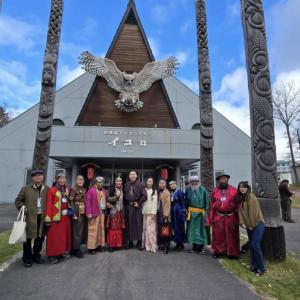R.Samiya: There are less than 50 mazaalais in Mongolia
VideoUnder
the theme ‘Conservation of Mazaalai – Public participation’, a conference for
the conservation of Mazaalai or Gobi Bear, the national pride of Mongolia, was
organized at the lecture hall of the National University of Mongolia (NUM).
American
and Norwegian scholars, who are
leading bear research projects, Lecturer of the NUM Department of Biology Prof.
R.Samiya, and representatives of NGOs engaged in the conservation of mazaalai
gave presentations at the conference.
Head
of the “Khongor Nutgiin Duudlaga Movement” NGO D.Batbold:
“The meeting is involving prestigious
bear researchers including Head of the American Association for Gobi Bear
Conservation Harry Raynolds, Norwegian brown bear specialist Jon Swenson, and
President of the International Association for Bear Research and Management
(IBA) Andreas Zedrosser. The IBA President is getting acquainted personally
with the gobi bear’s habitat. We are endeavoring to have the 2021 IBA
conference focus on mazaalai among the eight bear species that live in 36
countries around the world”
In
Mongolia, mazaalai conservation activities and researches have been intensified
since 1965 and some 36 mazaalais have been recorded in camera.
Lecturer of the NUM Department of Biology
Prof. R.Samiya
Mazaalai is rare not only in Mongolia,
but in the world. Thus, everyone has a responsibility to be attentive towards
the conservation of Mazaalai. Member of the International Association for Bear
Research and Management, American scholar Harry Raynolds has been doing
researches in Mongolia since 2006. Our knowledge about mazaalai was shallow
until just recently. But, we started using cameras in 2013 and certain
knowledge has been gained thanks to that. Last year in June and July, we
installed 56 cameras in 13 points near water areas where Gobi bears come to
drink and identified 36 different mazaalais. Thus, if we consider not all the
bears have been recorded, there are around 50 mazaalais in Mongolia”
The
participants of the conference also noted that the efficiency of the activities
of associations and research clubs that conduct various kinds of studies in
mazaalai conservation is not significantly growing due to the weak coordination among them.
Lecturer
of the NUM Department of Biology Prof. R.Samiya
“Since 2007, American researchers have
been observing migratory patterns, genetic features and genetic incompatibility
of mazaalais with tracking collars. The studies will help determine to which
bear species mazaalai is related and with which species it shall mate in case
of genetic degradation. A variety of studies, including registration and
tracking are being conducted. However, researchers are doing their work
individually and we are failing to systematize the initiatives. One of the
objectives of today’s conference is to address this issue. The desired result
will be obtained with involvement of not only individuals and NGOs, but with combined efforts.”
International
scholars consider mazaalai, which is inscribed on the national and global Red
Lists, unique among other bear species
 Ulaanbaatar
Ulaanbaatar














































































